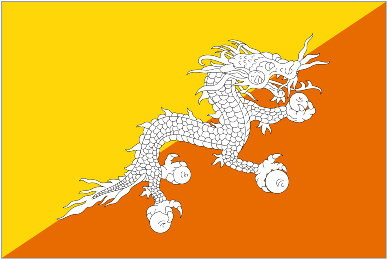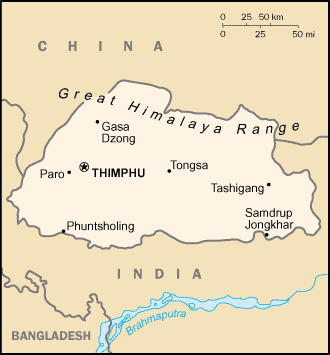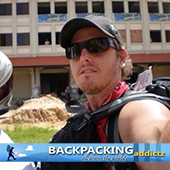- Population: 2.4 million (UN, 2005; some estimates are significantly lower)
- Capital: Thimphu
- Area: 38,364 sq km (14,812 sq miles)
- Major language: Dzongkha (official)
- Major religions: Buddhism (official), Hinduism
- Life expectancy: 62 years (men), 64 years (women) (UN)
- Monetary unit: 1 ngultrum = 100 chetrum
High up in the Himalayas is a place called Drak Yul, Land of the Thunder Dragon, conveyed clearly, with its national flag and a menacing dragon emblem in focus, a mighty independent country of strong policies in South Asia. This is perhaps way too much information than the outside world cares to know about the trivial-by-impression mountain kingdom. The Kingdom of Bhutan is a remote and almost mythical earthly paradise hailed one of and the last Shangri-la that evokes spirituality and oriental exoticism. True to the name, the Dragon Kingdom is among the last pristine places and undisturbed places in the planet.
GEOGRAPHY & CLIMATE
Bhutan (27 29 N, 89 36 E) is a pristine gem that continues to get richer in non-materialistic values. A look at the geography of the region might explain such lacklustre for material possessions. With its rich biodiversity and the 72.5% of the country’s 38,394 km2 land covered in forest (and increasing), the tiny nation may be perceived as a land of golden abundance, but, the harsh truth is that life in the grasslands is gruelling with only 7.8% of the total area arable for crops and vegetation. No wonder the Bhutanese can understand very well and appreciate the modest lifestyle provided by the land. There are two major river systems in Bhutan: Mo Chhu and Drangme Chhu which both support the land’s biggest money spinner, hydroelectricity. The overall terrain of Bhutan is mountainous with ranges as high as 1,500-2,700 metres/4,900-8,900 feet above sea level, with a few fertile valleys and savannahs. The highest point remains Kula Kangri, elevated 7,553 metres above sealevel, and the lowest point is Drangme Chhu, 97 metres above sea. Despite strong policies of environment preservation, the land is threatened with soil erosion and landslides, brought about by violent thunderstorms, the origin of the country’s name “Drak Yul”.
The kingdom is landlocked, meaning there are no coastlines or water territories, and sandwiched by countries of over 6 billion population around it. This is a great contrast to the parcels of the population in pockets such as the 50,000 people living in the capital of Bhutan, Thimpu. Population density is a player in the general 5-season climate of Bhutan just as much at is altitude. In the highlands, the climate is subtropical to temperate with hot humid summers and cold winters; while up north is a polar-type climate with year-round snow. In the West, monsoon comes with heavy rains, while central and eastern Bhutan is temperate and drier with warm summers and cool winters. Fall and spring are deemed the best times to fully enjoy the grandeur of Bhutan sans the muddy summer soils or the snow covered winter land.
PEOPLE & CULTURE
Legislatively, freedom of religion is propagated but it does not harbour the support by the royal government. Vajrayana Buddhism is the way of life in Bhutan besides being the state religion followed and practiced by 75% of the Bhutanese. Hinduism comes in second with 24% of the populace as followers of the faith, while an estimate of less than 1% practice other religions such as Islam, Christianity, and so on. Christians estimate to 65,000, the majority in Southern Bhutan, despite strict restriction towards non-Buddhist religions. Christians experience persecution in the form of withdrawal of Bhutanese rights to education, controlled practice and expansion of the Church, and oftentimes, even loss of citizenship. Succinctly, conversion from Buddhism is taboo, hence strictly forbidden.
The Bhutanese, the politically correct address to its nationals, consist of two major ethnic groups classified by region: Ngalops of Western Bhutan, and the Sharchops of the East. The Kingdom’s official language is DZONGKHA of the Ngalops, which is only 1 of the 24 languages spoken in Bhutan, but just like the country’s population, the language statistics is not well-characterized. ENGLISH and HINDI are both understood by people in the urban areas. English is widely taught in school and, therefore, used with signages written in both Drongka and English.
Population discrepancies number the Bhutanese from 691,141 in 2010 from 2,327,849 in 2007, which is beyond issues of inconsistency and statistics. Statistics of the Royal Government and the U.S. Bureau of Census are divergent resulting to some odd theories surfacing, such as a fabricated census to gain the Kingdom entry into the United Nations with its population requirements of at least a million. The deal is, as a country in extreme seclusion, no census was conducted until 2005, and it seclusion that the nation’s culture is bound and rooted.
After all, it is this seclusion that strengthened traditions, policies, values, unity and loyalty among the Bhutanese. The culture of the Bhutanese is devoid of material gratification having existed with a modest lifestyle since 500 BC, with firm emphasis on the values of living in harmony, controlling anger, overcoming jealousy and selfishness, and promoting tolerance and patience, which are as important subjects in school as math and science. Deeply rooted in the Buddhist traditions, the King aims for a slow haste where traditions exist and subsist in the face of 21st century rapid modernization.
The country’s quirky philosophy of Gross National Happiness is the brainchild of the Dragon King Jigme Singye Wangchuk wherein holistic happiness is mandatorily the focus and driving force behind any endeavour to development. The modest man is a pioneer of the principle with four wives, but admiringly, without Swiss accounts or lear jets on trail, the great king lives on the front foot in a log cabin quite humbly. In accordance with the King’s ways, the Bhutanese find everyday happiness from simple things like the ancient traditions of their national sport, archery.
FOOD & ATTRACTION
In the recent years that the Shangri-la has opened itself to the outside world of tourism, technology and television, the international audience is beginning to see the tiny nation as a jewel, not only for the Kingdom’s rare and dazzling characteristics, but the price it demands from its scant visitors. As one of the world’s most expensive countries to visit, tourism accounts for its second largest source of income. Bhutan is not set ideally for a backpacker’s travel budget with expenses per day averaging to an astounding $200, although it has the pristine and pure features and destinations that a backpacker will thirst for. More importantly, the Bhutanese do not view tourists as cash registers to follow around. At the end of the day, being in one of the world’s paradise on earth is an invaluable experience.
Back in the 60’s, to sink step in Bhutan’s soil requires a royal invitation from the King. These days, a passport and a ticket will do. The icon of Buddhism in Bhutan, the famous monastery Taktsang Monastery or “Tiger’s Nest” is a crown jewel of the nations where tourists are not allowed ultimate entry into, which is the similar case for Singye Dzong in Lhuentse. Jakar draws spectators as a sacred site where the earliest temple/relic, the Kurje Lhakhang can be seen. There are also other sites that are not off-limits such as the early Buddhist sites in Bumthang Dzongkhang, whereas Punakha and Wangdue are famous destinations for cultural tours that offer unique travel experiences as well. On the other, Zhemgang, a bird watcher’s paradise, is a barely explored region endowed with excellent fauna viewing while the East of Bhutan is the least trudged by visitors.
Food is hard to come by in Bhutan, as there are no places to eat or stay in while rigorously trekking the highlands. A Bhutanese meal consists of meat (pork, beef, yak, mutton, and chicken) and vegetable dishes cooked with chilli, which is of medium heat, accompanied by rice, a staple eaten in every meal. There are practically no other spices or condiments other than chilli and cheese-the predominant flavours in the national dish the Ema datshi. The traveller needs not head this way for dessert because fruits like watermelons, apples, and blackberries are enough to sate the Bhutanese sweet palette. Although, the traveller may satiate dessert cravings in Thimpu’s Art Cafe where cakes, pastries, brewed coffee, and empty calories may be enjoyed.
In a world of dictators and corrupt governments, this all sounds like the stuff of myths and fairytales where the government is free of the taint of corruption, while the King gives up absolute power to bring democracy to the people. There is no opposition, no political parties, just pure love and reverence for a government and a King who mixes with his people to reach out to them in close proximity and hold dialogues with them to make sure they are not going hungry and remain, well, “happy.”To question the King’s modus is punishable by treason, but the Bhutanese simply have no reason to.






Leave A Response